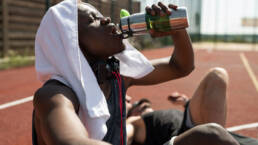Spring’s Back—And So Are Injuries
It’s that time of year again. The sun’s out, the trails are dry, and you’re finally dusting off your running shoes or pulling your bike from the garage. You’ve waited all winter for this moment—until a sudden twinge, pop, or pull reminds you: you might’ve jumped back in too fast.
Spring is prime time for “weekend warrior” injuries—those overzealous moments of athletic ambition that collide with winter’s inactivity. And if that sounds like you, you’re not alone. But the good news? Bouncing back is absolutely possible—and smarter, more efficient recovery starts with understanding the real issue and tackling it head-on.
Who Are Weekend Warriors, Really?
If your weekdays are packed with Zoom calls, spreadsheets, kid drop-offs, and back-to-back meetings—and your weekends are the only time you get to break a sweat—you, my friend, are a weekend warrior.
And you’re in good company.
Weekend warriors are the folks who might not have time to squeeze in daily workouts but *live* for those windows of opportunity when they can go all out. Whether it’s a 10-mile trail run, a Saturday CrossFit throwdown, a pick-up soccer match, or a full day of mountain biking, weekend warriors chase the rush of physical challenge as a break from the weekday grind.
There’s something admirable about that kind of drive. It’s about more than staying fit—it’s about reclaiming your time, blowing off stress, and reconnecting with movement in a way that’s fun and empowering. You’re not just working out—you’re *living*, pushing your body, and testing your limits.
But here’s the catch: intensity without consistency can be a setup for disaster.
Most weekday schedules don’t allow for the warm-ups, cool-downs, hydration, or mobility work your body truly needs. So when you jump straight into high-impact activity—after five days of being mostly sedentary—you’re asking your muscles, joints, and connective tissues to go from zero to full throttle in a heartbeat.
Think of it like revving a cold engine. It might start. It might run. But it’s also more likely to overheat, seize up, or stall—especially if it’s not well-maintained.
That’s why weekend warriors are one of the most injury-prone groups in the active community. Not because they’re doing something wrong—but because they’re doing too much, too fast, without giving their bodies the preparation or recovery time they deserve.
And when spring hits? That risk multiplies.
After a long winter of hibernation, your body is eager but not always ready. Muscles are tighter, connective tissue is less pliable, and your cardiovascular system might not be as conditioned as you think. You feel great at first—the adrenaline is pumping, the weather is perfect—but all it takes is one misstep, overextension, or sudden movement, and you’re dealing with an injury that could’ve been avoided with a little more planning and a lot more care.
But don’t worry—we’ve got your back (literally). Whether you’re brand new to the weekend warrior lifestyle or you’ve been pushing boundaries for years, Denver Sports Massage is here to help you stay active, bounce back fast, and keep doing what you love.
Common Springtime Injuries and What Causes Them
You’ve been dreaming about that first long bike ride, trail run, or tennis match since January. The sun’s finally out, the air smells like possibility, and you’re ready to go all in.
But here’s the thing: spring might be the season of renewal—but it’s also the *season of injury* for weekend warriors.
At Denver Sports Massage, we see it every year. March through May is when people hit the ground running—literally—and end up limping through the rest of the season.
Why? Because your body’s just coming out of hibernation mode. After months of being less active (let’s be honest—most of us move a little less in the winter), your muscles, tendons, and joints are tighter and less resilient. Then spring hits, and we go from zero to beast mode without warming up, stretching, or easing in. That sudden spike in intensity is a recipe for strain.
Let’s break down the most common springtime injuries we treat—and what causes them:
Ankle Sprains
Whether you’re hitting the trail, hopping into a HIIT class, or pivoting on the tennis court, lateral movement is risky when your ankles aren’t primed. Loose gravel, uneven terrain, or even a misstep can twist your ankle faster than you can react. And once you’ve sprained it, the surrounding muscles tighten up to protect it—making future injuries more likely unless treated properly.
Massage tip: Sports massage can reduce swelling, restore range of motion, and rebalance the surrounding muscles to help you heal faster and reduce re-injury risk.
Knee Pain & IT Band Syndrome
One minute you’re enjoying a sunny jog through City Park, and the next, your knee feels like it’s grinding with every step. Knee issues in spring are often caused by doing too much, too soon—especially if your winter training was minimal.
The culprit? Often it’s tight quads, hamstrings, or iliotibial (IT) bands pulling on the knee joint, creating inflammation and pain. Add in hilly terrain or new running shoes, and it’s a perfect storm.
Massage tip: A focused sports massage can loosen the fascia, improve hip alignment, and release tension in the IT band and surrounding muscles—giving your knee a much-needed break.
Hamstring Pulls & Quad Strains
Sudden sprints during soccer or bootcamp? Explosive squats on the first nice day of the year? We get it—you’re excited. But your hamstrings and quads might not be ready to handle all that force without some preparation.
When muscles are tight and cold, they’re more likely to tear under pressure. A minor pull might mean a few days of soreness. A serious strain could sideline you for weeks.
Massage tip: Post-activity massage increases circulation, encourages tissue repair, and helps prevent chronic tightness from becoming a bigger problem.
Rotator Cuff Injuries
If your spring includes tennis, pickleball, swimming, climbing, or even golf, your shoulders are getting a workout. And if they haven’t been used much since last season, those tiny rotator cuff muscles are vulnerable to strain—or worse, tears.
Rotator cuff injuries often creep up gradually, starting with mild discomfort and evolving into sharp pain, reduced range of motion, or weakness.
Massage tip: Soft tissue therapy targeting the shoulders, traps, and upper back can relieve pain, reduce tension, and support a safer return to movement.
Lower Back Pain
This one’s a classic. It hits runners, cyclists, weekend weightlifters, gardeners, and hikers alike. Whether it’s caused by poor posture, weak core engagement, or simply doing too much too fast, lower back pain can make everything else harder—sitting, sleeping, standing, you name it.
We see a spike in back pain during spring because people start lifting, hiking, biking, or golfing again without building up the supporting muscles first.
Massage tip: Deep tissue work and myofascial release through the lumbar spine, glutes, and hamstrings can dramatically reduce pressure and increase flexibility in the lower back.
So What’s the Real Cause?
All of these injuries might sound different, but they often stem from the same root issues:
- Lack of warm-up and cool-down routines
- Poor movement mechanics due to muscle imbalances or stiffness
- Dehydration and insufficient nutrition
- Ignoring body signals like tightness or minor aches
- Trying to cram a week’s worth of activity into one intense weekend
Your body wants to perform—it really does—but if you don’t prep it or support it afterward, something’s going to give. And it usually happens at the worst possible time.
That’s where intentional recovery comes in—and why massage therapy is one of the smartest investments you can make this season.
Why Recovery Gets Trickier With Age (and a Busy Life)
You might feel young at heart—and maybe even in great shape—but if you’re over 30, chances are your body’s already started to *quietly* change behind the scenes. Recovery just isn’t as fast as it used to be. You pull something during Saturday soccer, and instead of bouncing back by Monday, you’re still wincing by Wednesday (or longer).
So what gives?
Let’s break it down: as we age, our bodies naturally become a little less efficient at healing, repairing, and rebounding. That doesn’t mean you’re broken—it just means you need a smarter strategy.
Here’s why that post-injury bounce-back slows down with time and life:
Muscle Elasticity Declines
Remember when you could roll out of bed, stretch once, and hit the basketball court with zero warm-up? Yeah, those days fade as collagen production decreases and your muscles and tendons lose some of their natural elasticity.
That means when you do strain something, the fibers don’t spring back like they used to. Instead, they take longer to recover—and are more prone to microtears and inflammation.
Massage helps by increasing blood flow to these areas, warming tissues, and improving pliability—especially in chronically tight spots like hamstrings, shoulders, and calves.
Slower Circulation = Slower Healing
Your blood is the delivery system for everything your body needs to repair itself: oxygen, nutrients, immune cells. But with age, circulation isn’t quite as snappy. Combine that with a sedentary workweek, and your body just doesn’t have the resources moving fast enough to keep up with demand.
That means inflammation sticks around longer. Bruises linger. Soreness turns into stiffness. And that nagging calf cramp? It might take days instead of hours to resolve.
Massage therapy gets the blood moving, boosting circulation, flushing out metabolic waste, and speeding up healing.
Work-Life Balance Leaves No Room for Recovery
Even if you’re aware of your body’s needs, the reality is—life is *busy*. Between work deadlines, kids’ soccer games, and trying to maintain some kind of social life, proper recovery just doesn’t fit in the schedule.
Let’s be honest: How many times have you skipped your cool-down stretch because you had to rush to brunch? Or iced your knee once and thought, “that’s good enough”?
This lack of recovery time means your body starts stacking stress—physically and mentally. Over time, those little tweaks turn into chronic tightness, recurring injuries, or even burnout.
Scheduling regular massage sessions is one of the easiest ways to make recovery a non-negotiable part of your week. Think of it like preventive maintenance—just like you wouldn’t ignore an oil change for your car.
Chronic Inflammation Becomes More Common
As we age, our bodies become more prone to low-grade, chronic inflammation—especially if stress levels are high or nutrition isn’t perfect. This inflammation can quietly weaken tendons, reduce joint flexibility, and increase injury risk even before you notice anything’s wrong.
And when you do get injured? That background inflammation slows healing and increases pain sensitivity.
Massage helps lower inflammation naturally by stimulating lymphatic drainage and encouraging your body’s healing response—without medications or downtime.
You’re Not Warming Up (and You Know It)
Let’s face it: warming up felt optional when you were 22. Now it’s essential—but often skipped. Maybe you’re running late. Maybe you figure that “first mile is my warm-up.” But heading straight into full-intensity activity without prepping your muscles, joints, and connective tissues is a fast-track to injury.
And the older you get, the more important it becomes to move intentionally, prime your body, and recover *actively*—not passively.
Massage fits beautifully into this new routine. A pre-activity massage (especially for recurring problem areas like tight quads or sore shoulders) can improve tissue readiness and prevent setbacks before they happen.
The Bottom Line: Aging Doesn’t Mean Slowing Down—It Means Leveling Up
You don’t have to stop doing the things you love. In fact, many of our clients at Denver Sports Massage are in their 40s, 50s, and beyond—and are crushing it at their favorite sports and hobbies.
But what sets them apart is that they’ve learned to listen to their bodies. They plan for recovery the same way they plan for activity. They know that maintenance isn’t a luxury—it’s the secret weapon that keeps them in the game.
So whether you’re feeling the aftershocks of last weekend’s pickup game or you’re planning a big season of hiking, racing, or recreational sports—remember that recovery is no longer optional. It’s essential. And the older (and busier) you get, the more crucial it becomes.
How Massage Therapy Helps You Bounce Back
Massage therapy isn’t just about relaxation—it’s a serious tool for recovery. At Denver Sports Massage, we specialize in working with active people who want to move better, feel stronger, and stay in the game.
Here’s how massage accelerates healing and minimizes downtime:
Reduces Inflammation and Swelling
Post-injury swelling is the body’s natural response—but too much can slow down healing. Sports massage helps move excess fluid through the lymphatic system, relieving pressure and encouraging cellular repair.
Improves Circulation for Faster Healing
Massage boosts blood flow to injured tissues, delivering oxygen and nutrients right where they’re needed. This increased circulation helps speed up the regeneration of damaged muscle fibers and connective tissue.
Releases Muscle Tension and Scar Tissue
When you’re injured, your body often compensates by tightening up nearby muscles. This protective response can cause long-term imbalances. Massage therapy breaks up adhesions, reduces scar tissue, and restores range of motion.
Active Recovery: Doing More Than Just Resting
Rest is important—but active recovery is better. That means moving strategically, staying hydrated, and using targeted therapies like massage to encourage healing without overdoing it.
Stretching and Mobility Work
Gentle stretching and mobility drills can help you stay limber while you heal. Our therapists often recommend stretches tailored to your injury and activity level to help you maintain flexibility.
Hydration and Nutrition
Injured tissue needs hydration to heal. So drink more water than you think you need—and add anti-inflammatory foods (like berries, leafy greens, and omega-3s) to your diet.
Easing Back In
Don’t go from zero to a 10-mile trail run after a quad strain. Ease back in with low-impact movement, proper warmups, and shorter durations. A sports massage before and after your return to activity can help prevent re-injury.
Tailoring Massage to Your Sport or Activity
Every athlete—amateur or pro—uses different muscle groups. That’s why our therapists customize each massage to your specific needs and favorite activities.
Runners & Cyclists
You’re working your hips, hamstrings, calves, and quads. Massage can relieve tension in the IT band, reduce knee stress, and improve stride efficiency.
Hikers & Climbers
From glutes and calves to shoulders and forearms, you’re putting pressure on muscles that need active recovery. We help improve circulation, relieve tightness, and support grip strength and stability.
Golfers & Tennis Players
Rotational sports are notorious for spinal, shoulder, and elbow injuries. Our massage techniques target these areas, improving flexibility and reducing chronic overuse issues.
Denver Sports Massage: Your Recovery HQ
We’ve helped thousands of Denver-area athletes, weekend warriors, and fitness lovers feel better, move better, and perform better—without the constant cycle of injury and recovery.
Our therapists combine deep tissue massage, trigger point therapy, myofascial release, and sports-specific techniques to give you the best recovery experience possible.
Whether you’re dealing with a fresh injury or trying to prevent the next one, we’re here for you. Convenient scheduling, a comfortable environment, and therapists who understand athletes—it’s the Denver Sports Massage difference.
Conclusion: Get Back to Doing What You Love—Without the Setbacks
Spring is a time to get outside, test your limits, and rediscover your love of movement. But don’t let overuse, strain, or poor recovery sideline your season.
At Denver Sports Massage, we help weekend warriors like you stay active, heal faster, and play longer. Book your appointment today and bounce back better—because your best spring yet starts with smart recovery.

With unique treatment plans tailored specifically to each individual, our goal is to offer a comprehensive approach to healing and reducing pain. We pride ourselves on taking a holistic approach to massage therapy for pain and are committed to providing the highest quality care. If you’re looking for a massage therapist in Denver to help with pain, schedule an appointment today!
Like this article? Spread the word!
Related Posts
March 15, 2025
Ski & Snow Sports: Addressing Muscle Tightness and Fatigue, Injury Prevention, and the Benefits of Massage Therapy
Relieve muscle tightness and fatigue from skiing with massage therapy. Learn injury…
February 15, 2025
The Ultimate Recovery Plan for Skiers and Snowboarders: Avoid Injuries This Winter
Stay injury-free this ski season with a tailored recovery plan! Discover how Denver…
January 15, 2025
Your Secret Weapon for Sticking to New Year’s Resolutions: Sports Massage for a Strong Start
Discover how Denver Sports Massage can help you stick to your New Year’s resolutions.…




